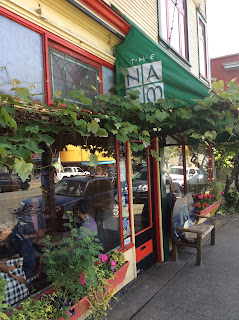 |
| Mark Wiens offers cotton candy at baseball tournament. |
 |
| Tents advertise Wiens' services in both Chinese and English. |
"Mark Wiens. Your Mandarin speaking Realtor," screamed the three bright orange-and-white shelters set up in the foreground of the baseball tournament I passed on Victoria Day.
It would have been hard to miss the message, given the huge lettering on the signs in both English and Chinese. But just in case, one of the tents also offered a cotton-candy operation, and it wasn't hard to deduce that one of the people stirring the pot, a tall guy in a suit, was probably Mark Wiens. I took only a couple of pictures before he spotted me and strode busily forward, proffering a cone of pink fluff.
To him, I probably looked like an owner of one of the neighbourhood teardowns just ready for demolition. To me, his name had rung a little bell, and besides, he was a curiosity. With the Vancouver market bursting with Asian money and plenty of Asian real-estate agents who speak Mandarin, what was the big deal about another Mandarin-speaking agent? Even if he was Caucasian? So I asked.
Wiens couched his words, but he got his point across. Groups of Asian buyers talk among themselves assuming the white guy can't understand, he said: Sometimes it helps. Not that he hides anything; it's on his card that he speaks Mandarin, but....I asked whether he could point to any specific case where his Mandarin meant a quicker sale or higher price, but he said it's more general than that -- sometimes things just lead to other things.
But there is one definite advantage, he said, and that is that he stands out. When buyers are seeing a large number of properties, things blend together in their minds, but they might remember the place where the white guy spoke Mandarin.
I went on to my coffee date, but the bell in my mind kept tinkling. Later, when I researched Mark Wiens, I was sent back to a night last summer. I'd hired a company to get rid of the chafer beetles that had been destroying my lawn, and the man who showed up for the late-evening task was an easy-talking, pleasant fellow who was studying for his real estate licence. He asked me to pass his name on to anyone needing an agent; I figured he'd do well. The man, of course, was Mark Wiens. From bugs to real estate-- a true Vancouver progression.
From Mark Wiens' website: "Before working in the real estate business, my start up business, Community Lawn Care, grew in four years to become the top rated lawn service in Vancouver, grossing a quarter of a million dollars in revenue and winning several industry awards. During this time I learned many lessons, and each opportunity has allowed me to improve myself."


















































